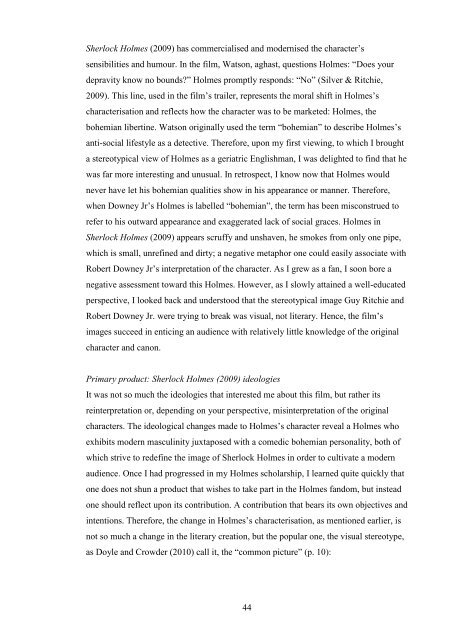The Case Study of Sherlock Holmes (2009) - Scholarly Commons ...
The Case Study of Sherlock Holmes (2009) - Scholarly Commons ...
The Case Study of Sherlock Holmes (2009) - Scholarly Commons ...
You also want an ePaper? Increase the reach of your titles
YUMPU automatically turns print PDFs into web optimized ePapers that Google loves.
<strong>Sherlock</strong> <strong>Holmes</strong> (<strong>2009</strong>) has commercialised and modernised the character‟s<br />
sensibilities and humour. In the film, Watson, aghast, questions <strong>Holmes</strong>: “Does your<br />
depravity know no bounds?” <strong>Holmes</strong> promptly responds: “No” (Silver & Ritchie,<br />
<strong>2009</strong>). This line, used in the film‟s trailer, represents the moral shift in <strong>Holmes</strong>‟s<br />
characterisation and reflects how the character was to be marketed: <strong>Holmes</strong>, the<br />
bohemian libertine. Watson originally used the term “bohemian” to describe <strong>Holmes</strong>‟s<br />
anti-social lifestyle as a detective. <strong>The</strong>refore, upon my first viewing, to which I brought<br />
a stereotypical view <strong>of</strong> <strong>Holmes</strong> as a geriatric Englishman, I was delighted to find that he<br />
was far more interesting and unusual. In retrospect, I know now that <strong>Holmes</strong> would<br />
never have let his bohemian qualities show in his appearance or manner. <strong>The</strong>refore,<br />
when Downey Jr‟s <strong>Holmes</strong> is labelled “bohemian”, the term has been misconstrued to<br />
refer to his outward appearance and exaggerated lack <strong>of</strong> social graces. <strong>Holmes</strong> in<br />
<strong>Sherlock</strong> <strong>Holmes</strong> (<strong>2009</strong>) appears scruffy and unshaven, he smokes from only one pipe,<br />
which is small, unrefined and dirty; a negative metaphor one could easily associate with<br />
Robert Downey Jr‟s interpretation <strong>of</strong> the character. As I grew as a fan, I soon bore a<br />
negative assessment toward this <strong>Holmes</strong>. However, as I slowly attained a well-educated<br />
perspective, I looked back and understood that the stereotypical image Guy Ritchie and<br />
Robert Downey Jr. were trying to break was visual, not literary. Hence, the film‟s<br />
images succeed in enticing an audience with relatively little knowledge <strong>of</strong> the original<br />
character and canon.<br />
Primary product: <strong>Sherlock</strong> <strong>Holmes</strong> (<strong>2009</strong>) ideologies<br />
It was not so much the ideologies that interested me about this film, but rather its<br />
reinterpretation or, depending on your perspective, misinterpretation <strong>of</strong> the original<br />
characters. <strong>The</strong> ideological changes made to <strong>Holmes</strong>‟s character reveal a <strong>Holmes</strong> who<br />
exhibits modern masculinity juxtaposed with a comedic bohemian personality, both <strong>of</strong><br />
which strive to redefine the image <strong>of</strong> <strong>Sherlock</strong> <strong>Holmes</strong> in order to cultivate a modern<br />
audience. Once I had progressed in my <strong>Holmes</strong> scholarship, I learned quite quickly that<br />
one does not shun a product that wishes to take part in the <strong>Holmes</strong> fandom, but instead<br />
one should reflect upon its contribution. A contribution that bears its own objectives and<br />
intentions. <strong>The</strong>refore, the change in <strong>Holmes</strong>‟s characterisation, as mentioned earlier, is<br />
not so much a change in the literary creation, but the popular one, the visual stereotype,<br />
as Doyle and Crowder (2010) call it, the “common picture” (p. 10):<br />
44

















